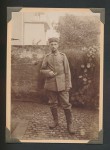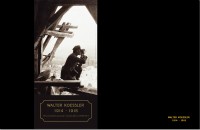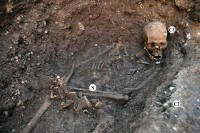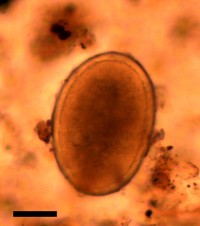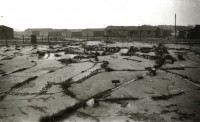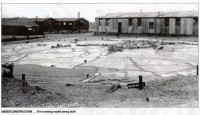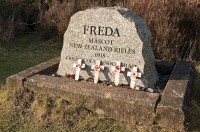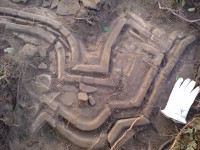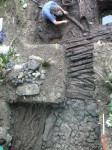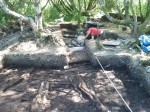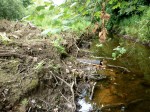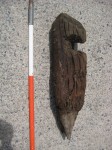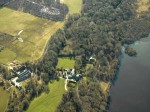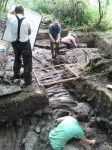Amateur archaeologists Hans Henrik Hansen and his nephew Christian Albertsen were exploring a field near the Danish village of Boeslunde, southwestern Zealand, with metal detectors this June 18th when they discovered two bracelet-sized gold rings. They immediately brought the rings to the Zealand Museum where curator Kirsten Christensen recognized them as “oath rings,” arm rings that are open-ended with decorated funnel-shaped tips. Hansen and Albertsen told her they were off to find more of them and returned to the field the next day where they found another two rings within meters of the first two. They are from the Late Bronze Age and date to around 800 B.C.
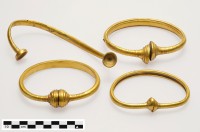 Oath rings have been found before in this very field. The four new discoveries have almost doubled the number of rare gold oath rings discovered in this spot, bringing the total up to ten. In all of Denmark, only about 50 oath rings are known to have been unearthed. If that weren’t remarkable enough, the other six were discovered one at a time over a period of three decades. Never before have four been found together. The total weight of the ten oath rings from this field is more 3.5 kilos (7.7 pounds). These four range in weight from 95 grams (3.5 ounces) to 290 grams (10.23 ounces), lighter than most of the six previous discoveries which range from 220 grams (7.76 ounces) to 770 grams (27.16 ounces). Arm rings are not the only Bronze Age gold found in the area. Another two kilos of gold artifacts (mainly bowls) have been discovered over the years, indicating that the Boeslunde area was a center of wealth during the Late Bronze Age.
Oath rings have been found before in this very field. The four new discoveries have almost doubled the number of rare gold oath rings discovered in this spot, bringing the total up to ten. In all of Denmark, only about 50 oath rings are known to have been unearthed. If that weren’t remarkable enough, the other six were discovered one at a time over a period of three decades. Never before have four been found together. The total weight of the ten oath rings from this field is more 3.5 kilos (7.7 pounds). These four range in weight from 95 grams (3.5 ounces) to 290 grams (10.23 ounces), lighter than most of the six previous discoveries which range from 220 grams (7.76 ounces) to 770 grams (27.16 ounces). Arm rings are not the only Bronze Age gold found in the area. Another two kilos of gold artifacts (mainly bowls) have been discovered over the years, indicating that the Boeslunde area was a center of wealth during the Late Bronze Age.
The four rings are all different, although they do share some decorative features like meander patterns, snaking bend patterns like a river seen from above. Those meander patterns are a stylistic feature of Late Bronze Age (950-800 B.C.) metal work which is how the rings were dated. The rings all show significant wear, especially on the tips were some of the decoration has been almost entirely eroded away, which means they were not made solely for sacrifice in a religious ritual, but rather worn by a person or people whose skin and clothing rubbed against the soft gold leaving marks over time.
One of the six previously discovered rings, this one found in 2009, has a similar wear pattern and is in the same weight range as the new four. It was also found near the same spot where the four were unearthed. The five rings could well have been buried together and then been separated by later agricultural interference. All four of the new rings show signs of having met the business ends of plows or harrows. One ring is bent entirely out of its circular shape, and the other three have nicks and scrapes from their encounters with farming tools.
Oath rings have been found in graves of high status men, and only men, as well as in sacrificial pits. Although they were worn for an extended period of time, the Boeslunde rings were all discovered buried on their own, not associated with a grave. Archaeologists plan to return to the find site later this year to find out more about the context, whether they were buried in a bog hole like most of the rings discovered in the area or deposited in some other way. Gold sacrifices in the Bronze Age were often deposited in watery areas, primarily bogs and lakes, but they have also been found buried in soil next to boulders or in barrows.
Having said all this, these rings are not actually oath rings which is why I used quotation marks in the title. In the early 19th century, there was a trend among historians to look in the Icelandic sagas for explanations of pretty much every ancient artifact found. Gold arm rings make an appearance in several sagas as objects used in religious rituals, worn by priests and used by parties in court cases to swear oaths upon the way the Bible is used by believers today.
From the Landnámabók, meaning “The Book of Settlements,” a medieval Icelandic book detailing the settlement of Iceland by the Norse in the 9th century and beyond:
A ring weighing two ounces or more should lie on the stall in every chief Temple, and this ring should every chief or godi [, a local chieftain with administrative and religious duties,] have upon his arm at all public law-motes (logthing) at which he should be at the head of affairs, having first reddened it in the blood of a neat which he himself had sacrificed there. Every man who was there to transact any business, as by law provided by the Court, should first take an oath upon that ring and name for the purpose two or more witnesses and repeat the following words: “I call to witness in evidence,” he was to say, “that I take oath upon the ring, a lawful one (lögeid) so help me Frey and Niord and the Almighty God, to this end that I shall in this case prosecute or defend or bear witness or give award or pronounce doom according to what I know to be most right and most true and most lawful, and that I will deal lawfully with all such matters in law as I have to deal with while I am at this Thing.”
“Thing” here means a governing assembly of free men that met at regular intervals to pass new laws, elect leaders, adjudicate disputes and make political decisions.
The open-ended arm rings became associated with the oath-taking rings. Eventually archaeologists recognized that the so-called oath rings were made and buried thousands of years before the time of the sagas, but by then the name had stuck and remains in use as an asterisked convention today.
The four newly-discovered oath rings are now on display at the National Museum of Denmark in Copenhagen.
